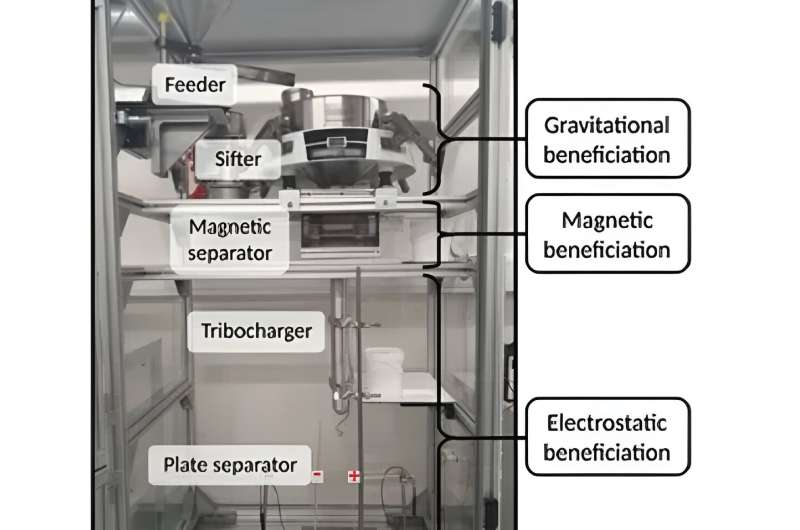This article has been reviewed according to Science X's editorial process and policies. Editors have highlighted the following attributes while ensuring the content's credibility:
fact-checked
trusted source
proofread
Researchers develop a test bed for separating valuable material on the moon

It's often better to flesh out technologies fully on Earth's surface before they're used in space. That is doubly true if that technology is part of the critical infrastructure keeping astronauts alive on the moon.
Since that infrastructure will undoubtedly use in-situ resources—known as in-situ resource utilization (ISRU)—developing test beds here on Earth for those ISRU processes is critical to derisking the technologies before they're used on a mission.
That's the plan for a test bed designed by researchers at the German Aerospace Center in Bremen—they designed it to improve how well we gather water and oxygen from lunar regolith. Unfortunately, as their work described in a recent paper published in Frontiers in Space Technologies demonstrates, it will be a challenge to do so.
Water and oxygen are two critical components of any long-term lunar exploration plan. One of the best sources for that on the moon, other than water ice that might only be available at specific locations, is a mineral called ilmenite. Ilmenite is a combination of iron, titanium, and oxygen—FeTiO3. It's also the most accessible material to split into its parts using a relatively low-energy chemical reaction with elemental hydrogen as a feedstock.
After reducing ilmenite with hydrogen, the resulting elements are iron (useful for building materials), titanium dioxide (useful for optical coatings), and water (useful for plenty of things). A further step could reduce the water to oxygen (again, useful for many things, including breathing) and hydrogen, which can be recycled back into the feedstock system for the following processing round. So, in the end, if you have ilmenite, you have access to cheap building materials, rocket fuel, and gas for breathing.
Unfortunately, ilmenite is not particularly common on the lunar surface. While it is somewhat plentiful in the mare regions, it is much less so in the highlands where the first permanent lunar outposts are planned. So explorers will need a technological solution to find more ilmenite—or at least concentrate it to levels where subjecting it to the reduction process would be energy efficient.
That's where beneficiation comes in. It is the process of separating valuable materials, such as ilmenite, from the "chaff" that makes up most of the lunar regolith—the most easily accessible resource on the moon.
Given a lack of readily available lunar regolith, the researchers used a regolith simulant when putting their test bed through its paces. That testbed consists of three machines for three main processes: gravitational, magnetic, and electrostatic beneficiation, and the paper goes into detail about each of them.
Before any testing, the regolith simulants were dried for upwards of 48 hours at a temperature of 80°C. Afterward, they were stored in a sealed container to prevent any additional moisture from entering the system.
The gravitational process uses a feeder, which is fed 300 g of dried simulant for every test run, and a sieve, which separates particles that are more than 200 micrometers in size. Studies from samples collected by Apollo astronauts showed that most ilmenite grains ranged from about 45–75 micrometers, so most of the ilmenite should make it past this stage. At the same time, larger particles that could hinder the performance of the rest of the system are weeded out.
Next up is the magnetic separator—ilmenite is weakly magnetic due to its iron content and, as such, can be separated from non-magnetic material of a similar density by subjecting it to a magnetic field. The magnetic field is directed such that it would push the particles of ilmenite out of a straight line when falling, directing them into a different hopper. Non-magnetic materials of a similar size would fall directly down and be filtered out by the system.
Finally, the remaining magnetic particles are subjected to massive electric fields using an electrostatic parallel plate separator. Typically used in the oil and gas industry, these devices introduce a gigantic electric field that suspends some particles, slowing their descent and making it possible to sort out materials with specific electrical properties. Characterizing the most effective way to utilize this step was a major focal point of the study.
After all that sifting and sorting, ideally, the users would end up with all the ilmenite in the sample and nothing else, but that doesn't happen in practice. Realistically, some of the ilmenite present in the sample would be lost as part of the filtering process, and some non-ilmenite particles make their way to the final collection point despite all the various methods to get rid of them.
In this experiment, the final mixture was about 12% ilmenite by weight, compared to 2.55% before it was beneficiated. The system also recovered around 32% of the total ilmenite available in the sample, and it took about half an hour to run a full 300 g sample through the test bed.
Further iterations could improve all those numbers—that is what test beds are for. This is only one of numerous steps that have to happen to finally make use of some of the more valuable resources on the moon. The quicker we're able to, the better.
More information: Kunal Kulkarni et al, Optimizing lunar regolith beneficiation for ilmenite enrichment, Frontiers in Space Technologies (2024). DOI: 10.3389/frspt.2023.1328341
Provided by Universe Today





















